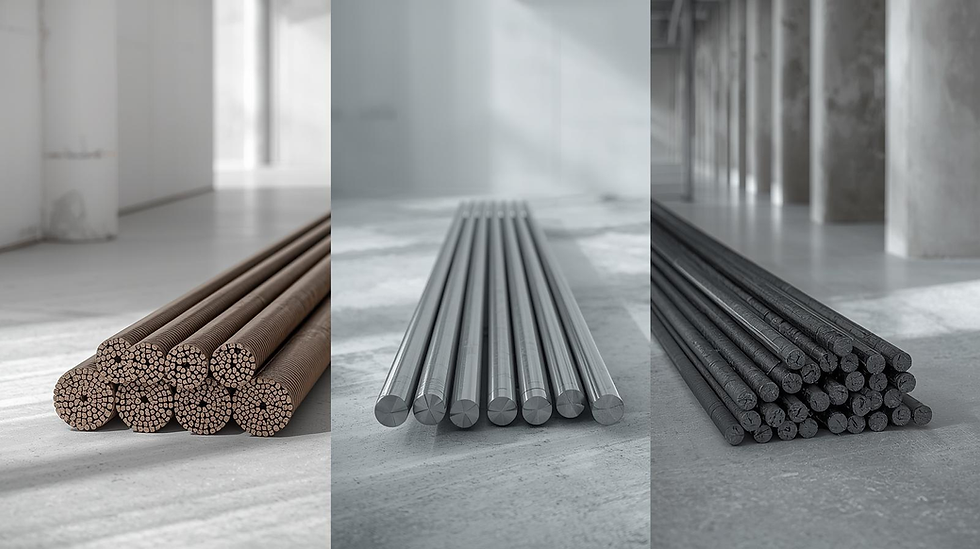Glass Fiber Reinforced Polymer Rebar: A Future-Ready Alternative to Steel
- Kamal Sharma
- Jun 24
- 3 min read
The infrastructure and construction sectors have always favored evolution. Over the years, the materials used in the construction have progressed, from mud and clay to steel. But that is not the limit. With sustainability, longevity, and cost-effectiveness becoming a priority, glass fiber-reinforced polymer (GFRP) rebars are now in the trend.
But are these materials better than steel? If yes, then how? Let’s find out:
Composition of glass fiber reinforced polymer rebar
The manufacturing process of GFRP rebars involves embedding glass fibers within polymeric resins. These two components work hand in hand. The fibers provide strength, while the resin binds them together, which helps with transferring pressure and adding chemical protection.
Here, it is essential to note that the resin used can impact the properties of the rebar. Thermoplastics help to reshape the rebar under heat, hence the industry leans on thermosetting resins like Epoxy, Polyester, or Vinyl Ester for better stability and durability.
GFRP vs. Steel: Which one is better?
In the modern construction industry, GFRP is not just a substitute for steel. It is a smarter choice for smart construction. For decades, steel rebar has served as the backbone of reinforced concrete structures. However, it is not without limitations. Corrosion for instance, plus heavy weight, and conductivity also add to its drawbacks.

Here’s where GFRP becomes a better alternative:
1. Corrosion Resistance
Steel may rust. GFRP won’t. Though it may be simple like a simple difference, in the construction sector the changes are big. Be it marine structures, sewage plants, or chemical factories, corrosion eats away at steel over time.
But this increases maintenance costs and increases safety risks. Glass fiber-reinforced polymer rebar, on the other hand, is immune to corrosion. Due to their non-metallic properties, they don't rust even in chemical exposure, ensuring structural integrity for decades with minimal upkeep.
2. Strength Without the Weight
Do you think strength always comes with weight? This raw material will make you think again. GFRP boasts an impressive strength-to-weight ratio. Even though it has similar tensile strength to steel, it is 75% lighter than steel.
If the weight gets reduced, it also cuts down transportation costs, eases manual handling, and reduces installation time. For projects like bridges, and high-rise construction, it brings both safety and savings to the table.
3. Electrical and Thermal Insulation
Steel conducts electricity and heat. So, you can’t use them in environments where current leakage or heat transfer occurs, as it can lead to serious hazards. GFRP is an electrical insulator, making it invaluable in power plants, MRI rooms, substations, and metro rail infrastructure. Its low thermal conductivity also supports energy-efficient design, especially in areas with wide temperature swings.
4. Long-Term Durability
When you are investing in a construction project, it is only natural to want a long life span. For steel, you need to apply coatings, treatments, and regular maintenance to avoid corrosion.
Glass Fiber Reinforced Polymer Rebar is inherently resistant to decay. It doesn’t flake, crack, or weaken in aggressive environments.
5. Sustainability
Who is not familiar with sustainability? Global issues have made their way into our daily lives. GFRP rebars offer a cleaner alternative than steel. They don’t leach chemicals into the soil or water. Because of their lightweight nature, your fuel consumption during transport becomes lesser. Most importantly, they require fewer replacements over time, reducing material usage and construction waste.
6. Cost-Effectiveness
The initial investment of GFRP may be slightly higher than traditional steel. However, if you consider long-term savings it is a much better choice. With GFRP rebars, you get to enjoy:
minimal maintenance
reduced downtime
lower transportation and labor costs,
Longer life span.
Final Thoughts
As time passes, infrastructure projects are getting more creative. So, to meet the current requirements, you need something that lasts longer, adapts to evolving needs, and stands strong in the face of climate challenges. Glass fiber-reinforced polymer rebar meets all the check boxes, making it a better alternative than steel.



Comments